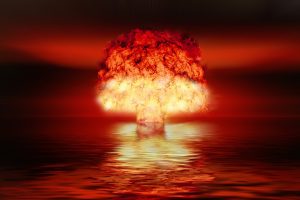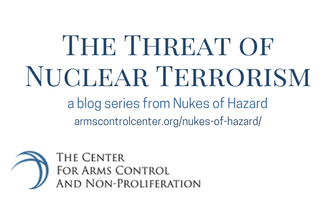By Anna Schumann
Less than one month ago, I started a new job — a dream job, in every sense of the word, and I’m not just saying that because my new boss will read this — as the Communications Director for the Center. I was hired for my communications experience and, as has been my experience in other positions, I knew I would be well versed in the Center’s focus areas soon. I’ve spent my first days listening to my colleagues, attending meetings, learning about all the resources we offer, reading news on nuclear non-proliferation and arms control, and preparing social media posts.
About a week ago, a new opportunity arose that I couldn’t resist. My boss sent me an email with information about a MOOC — a massive open online course — at Stanford University, being led by former Secretary of Defense William J. Perry, titled “The Threat of Nuclear Terrorism.” He only sent it to me to include it in the Center newsletter and to post on social media. But I wanted to take it one step further — I knew I needed to enroll. (When I was a newspaper reporter, I enrolled in the local Citizens’ Fire Academy and Citizens’ Police Academy and wrote each week about those experiences. I anticipate this will be equally entertaining — and infinitely less humiliating, considering that when I first put on full firefighter gear, I was so top-heavy that I fell face-first out of the firetruck.) I pitched the idea to him and he agreed that the course would be good for my education, and that blogging about it could be a great way to promote it to others who might be interested.
My fellow course participants and I were encouraged to introduce ourselves and explain our interest in the course in our first post. The participants span the globe — I’ve seen posts from Greece, Turkey, Qatar and New Zealand — and their knowledge of nuclear issues runs the gamut. There’s Gerry, the retired nuclear material safeguards inspector; Bob, a retired soldier who served during the Cold War preparing for nuclear attacks; Pete, a self-described “lifelong learner” wanting to gain knowledge on a new subject; Ashley, an attorney hoping to learn more about the nuclear threat so she can educate others; and Sally, who is taking the course while in hospice care because she is concerned for future generations. It is exciting to be in the company of people who are interested in increasing their nuclear knowledge for so many different reasons. As with everything in life, I know the diversity of participants will add richness and depth to this experience.
The course introduction was mostly instructions on using the platform, but it also included an “on the street” video to gauge public knowledge about nuclear weapons. Some of the questions, I could answer, such as how many nukes the U.S. has. (I couldn’t have answered correctly — about 7,000 — a month ago; I am learning!) Can there be a winner in nuclear conflict? I think my answer to that has always been “no.” But some of the questions were a little harder to answer, such as whether a world without nukes is possible. One person on the video said it might be, but humans will just find another way to destroy each other. Another said it’s difficult for others to get rid of their weapons when the U.S. still has them, and another echoed disbelief that the U.S. would ever agree to get rid of its nukes. The video ended with an interviewee saying a nuclear-free world is only possible if we dare to imagine it so, and that as a person with no nuclear knowledge, she hopes it’s possible.
As a person with slightly more than no nuclear knowledge, I have to agree that nuclear disarmament is always the goal. I hope that after completing this course, I can provide thoughtful answers to questions like this, and to the others the world is asking right now about nuclear capabilities, policies and probabilities. And I hope you will join me on my quest for more knowledge.


